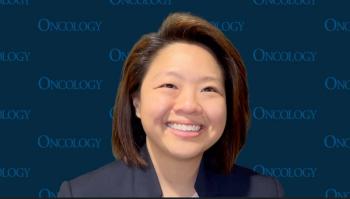
- ONCOLOGY Vol 14 No 8
- Volume 14
- Issue 8
Commentary on Abstracts #341, #347, and #333
Gómez-Bernal et al (abstract #341) report the results of a docetaxel (Taxotere)/vinorelbine (Navelbine) combination as second-line therapy for metastatic breast cancer. Both agents were administered on the same day and repeated every 14 days. The 52% objective response rate is impressive, since vinorelbine alone would be expected to produce a 20%–30% response rate in this setting, with docetaxel projected to achieve a 40% complete and partial remission rate. Therefore, the results suggest an additive interaction between the two agents.
Gómez-Bernal et al (abstract #341) report the results of a docetaxel (Taxotere)/vinorelbine (Navelbine) combination as second-line therapy for metastatic breast cancer. Both agents were administered on the same day and repeated every 14 days. The 52% objective response rate is impressive, since vinorelbine alone would be expected to produce a 20%–30% response rate in this setting, with docetaxel projected to achieve a 40% complete and partial remission rate. Therefore, the results suggest an additive interaction between the two agents.
Neutropenia and neutropenic fevers were frequent (29.1% and 22 episodes, respectively), and there was one case of fatal neutropenic enterocolitis. Otherwise, the combination was devoid of serious side effects or toxicity. The authors note that the use of hematopoietic growth factors is recommended. This is a very active regimen for second-line therapy, and provides an excellent treatment option for patients previously exposed to, and perhaps refractory to, an anthracycline-containing regimen.
Gralow and coworkers (abstract #347) designed a sequential schedule of administration for these same two agents, with continuous granulocyte colony-stimulating factor (G-CSF, filgrastim [Neupogen]) support. With growth-factor support, they were able to maintain a high dose intensity for vinorelbine. With a modest degree of neutropenia and neutropenic fevers, 61% of their patients achieved a major objective response. This is impressive, since half of their patients had been previously exposed to paclitaxel (Taxol) and all had anthracycline-resistant breast cancer.
This level of activity is similar to that reported by several investigators in first-line therapy of metastatic breast cancer with similar combinations, although with a lower dose intensity. One could only speculate about the therapeutic efficacy of this regimen in patients with anthracycline-sensitive breast cancer.
The third abstract (#333) reports the results of a similar combination, although the dose intensity of vinorelbine was lower, and that of docetaxel higher than in the Seattle experience (Ellis GK et al: J Clin Oncol 17:1407-1412, 1999). Granulocyte colony-stimulating factor was allowed, but not mandated. The antitumor activity of this combination in second-line therapy of breast cancer is reminiscent of the activity of some of the best cytotoxic regimens in first-line treatment of metastatic disease. However, comparisons between phase II trials are fraught with danger; therefore, the optimal evaluation of this two-drug regimen will require randomized trials comparing it to standard second-line regimens, including full-dose, single-agent docetaxel.
Articles in this issue
over 25 years ago
Commentary on Abstract #280over 25 years ago
Commentary on Abstract #527over 25 years ago
Commentary on Abstracts #986 and #1015over 25 years ago
Commentary on Abstract #1916over 25 years ago
Commentary on Abstracts #407 and #424over 25 years ago
Commentary on Abstracts #349 and #1259over 25 years ago
Commentary on Abstracts #317 and #322over 25 years ago
Commentary on Abstracts #254 and #330over 25 years ago
Commentary on Abstract #336over 25 years ago
Commentary on Abstracts #403 and #278Newsletter
Stay up to date on recent advances in the multidisciplinary approach to cancer.

















































































